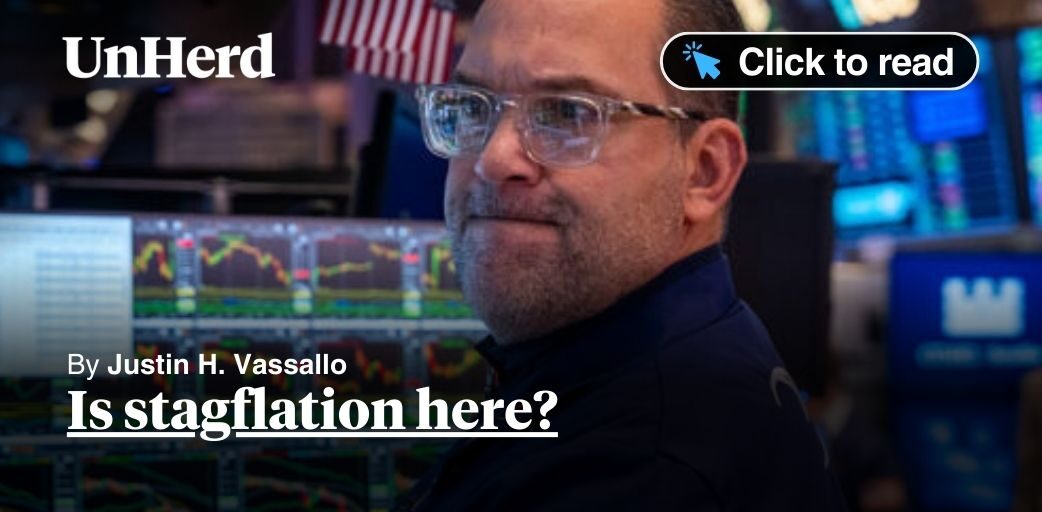As Donald Trump hit the 100-day mark of his second presidency, news of a first quarter economic contraction seemed to confirm most voters’ fears about his tariff gambit. At 0.3%, it was smaller than the first quarter contraction of 2022, the sole dip of former President Joe Biden’s term, when pandemic stimulus policies were winding down and inflation was peaking. Yet the impact of April’s market sell-off, pauses on inventory orders and investment, ebbing international trade flows, and the 145% tariff rate on China has yet to fully reverberate through the economy. Absent a radical reversal in Trump’s trade posture, mainstream economists warn, stagflation — a combination of high inflation, stagnant or falling output, and rising unemployment — is imminent.
Trump has been unfazed by such warnings, glibly stating that children will “maybe” have fewer “dolls” than they used to. And for those who believe Trump is playing four-dimensional chess, fundamentally shifting the makeup of the American economy, decoupling from China, and reducing the overall trade deficit — all this is worth the pain. This, even as few of these cheerleaders have indications of what it is that Trump wants America to produce more of, and fewer still have realistic estimates of how long it will take to achieve all these ends.
The problem is that stagflation isn’t a blip or temporary “market correction” from which it will be easy for the US economy to emerge with greater dynamism. Rather, it is a series of mutually reinforcing negative trends that sap the willingness of firms to expand while progressively exhausting purchasing power for household essentials. That leaves less money in the economy for hiring and training, innovation, and the productive risk-taking Trump purportedly wants. Unless he imposes price controls and leans on the 1950 Defense Production Act and other emergency measures — “statist” decisions which even a MAGA-fied GOP is likely to denounce — Trump has no Plan B to simultaneously restrain costs and compel industries to reshore.
Many, then, have remarked that Trump’s main economic policies will have the opposite of their intended effect of reinvigorating the US industrial base. But there is another irony here. Despite his unflagging drive to browbeat firms and the Federal Reserve into supporting reindustrialisation, this radical “conservative” President may soon encounter what all progressive and Left-wing governments have feared since the “great inflation” of the Seventies: a capital strike. In other words, the CEOs and financiers who rallied to Trump in 2024 may decide his whims are too disruptive to stay onboard — and that his apparent indifference to their profit margins, logistics, and ability to reasonably plan investments aren’t worth the candle.
The darkening forecast for growth precipitated so single-handedly by Trump’s management and priorities certainly has no modern precedent in US politics. But the deep uncertainty at all levels of the economy also underscores how difficult it is to alter, much less dramatically reverse, globalisation. It is much easier to transfer supply chains from high-wage countries to low-wage ones than the other way around.
During Trump’s first-term trade war, Vietnam, not the US Rust Belt, was the primary beneficiary of high tariffs on China’s exports. Unless Trump resumes some of the punitive rates he paused after his “Liberation Day” tariff formula was roundly maligned, capital expenditure will be rerouted to other emerging markets — some of which the Biden administration tried to cultivate as part of its own “friend-shoring” strategy of Chinese containment. Yet swinging back to a uniformly aggressive tariff regime could rock the global economy, needlessly punishing foreign workers in textiles, small appliances, toys, and other entry-level sectors while precipitating shortages for American consumers.
Trump’s isolationist tendencies — which aren’t congruent with a positive of vision of economic nationalism — are also impeding efforts to improve America’s global share of manufacturing. Trump needs the cooperation of allies he’s gravely alienated if he intends to effectively curb Chinese trans-shipment of inputs that he wants American firms to make. However, neither he nor his closest advisers appears temperamentally prepared to make that case. Likewise, it seems impossible for them to accept that “near-shoring” of key components with strict limits on Chinese content is preferable to China’s increasing command of critical supply chains.
In turn, Trump’s constant jaw-boning could result in fewer concessions of a strategic nature. Trade barriers without multilateral coordination that fosters “reciprocal” industrial policies and content standards among close allies will do more to isolate America than insulate it from practices which undercut its manufacturers. While some unfair trade practices can be addressed by eliminating loopholes like de minimis, which allowed Chinese producers to sell and ship goods valued $800 or less directly to American consumers, Trump still lacks a plan to persuade multinationals and mid-size firms to transition away from third-party suppliers that perpetuate dumping and other harmful practices.
The ostensible carrot in all of this is Trump’s insistence that lower corporate taxes and deregulation will lure foreign investors to build in America. On the face of it, the logic is quite simple: if major foreign competitors want to avoid tariffs, they should treat the US labour market as worthy of investment. But Trump has not pursued the types of industrial policies that Biden launched, which could convince more foreign firms of the benefits of doing just that. There are clear downsides to Trump’s approach, too. The risks posed to workplace safety and pollution standards are worrisome enough, but there is also the matter of business’s confidence in America’s domestic political stability and the skill-level of its workers.
Contrary to the libertarian notion that enterprise wants only a nightwatchman state, fanatical deregulation and slashing state capacity are not particularly encouraging for firms concerned with high-value-added manufacturing and standards compliance across the supply chain. In fact, the Left-wing school of thought which critiqued “corporate liberalism” delineated why a strong administrative state was integral to making and stabilising modern American capitalism. While some government policies have made it onerous to build efficiently in America, new research indicates that DOGE’s actions and similar cuts to federal research and development are likely to retard growth and make Americans significantly poorer, compounding the near-term losses imposed by passed-on tariff costs.
All else being equal, that will have a chilling effect on long-term fixed investment. Many companies will doubt that the broader political economy, which already favors financial rents over productive investment, and which Trump seems unwilling to reform in this respect, will justify opening new plants and keeping them operational for decades.
Given the limited policy options the Trump administration is working with, there are few other levers to pull. Trump may create enough instability in the interim to significantly lower the dollar’s value, theoretically enhancing the competitiveness of American manufacturing. A possible analogue here is the 1985 Plaza Accord orchestrated by the Reagan administration, which temporarily boosted American exports, albeit at considerable cost to developing nations that had piled up debt to diversify their economies. However, America’s industrial capacity is far more diminished than it was after the 1981-1982 Volcker Shock and ensuing recession, again illustrating the “input” dilemma created by decades of offshoring. Trump wants to replace foreign inputs with American-made ones, but a weaker dollar would make plant investment more costly, since to some extent the country needs to temporarily increase imports of capital goods to efficiently rebuild domestic supply chains.
Some may counter that the dollar has long been overvalued, and that this has worsened inequality by rewarding short-term financial gains, favoring consumption of cheap imports, and eliminating the pathways to middle-class prosperity historically provided by American manufacturing. In fact, Sen. Elizabeth Warren (D-Mass.) and other prominent voices on the progressive Left made these arguments in the last decade. Yet Trump has not signalled how a weaker dollar in the current context would reduce, rather than exacerbate, international supply chokepoints. Nor has he indicated in the slightest how it would translate into a less financialized economy. Tanking global confidence in the dollar — and US Treasuries as a safe haven — is not a recipe on its own for curbing speculative finance, which Trump has otherwise encouraged through his alliance with the libertarian Tech Right and support for cryptocurrencies.
In the meantime, it is possible the early phase of stagflation is already unfolding. In anticipation of broad price hikes from tariffs, consumers binged on spending the last two months, likely masking the extent to which a slowdown has been set in motion by Trump’s capricious strategy to boost domestic industry. Unease over supply costs, meanwhile, has further reduced manufacturing orders and output, according to the Institute of Supply Management, a leading industry association. On the positive side, the hiring freeze detected last year appears to be gradual, unemployment remains low, and the last two job reports were better than expected. But the long-term jobless still number 1.7 million people, or nearly 1 of 4 unemployed workers; that level, reached last November, is a half million more than a year ago.
As falling consumer confidence underscores, spending is based on fears of rising inflation, rather than optimism about wages and spending power, and that tariffs are cooling, not spurring, plant investment. Historic levels of household debt also suggest necessities are eating into disposable incomes. That is not an auspicious sign for manufacturers worried about whether new investments will be met with stronger demand. Another consecutive quarterly contraction would officially mark a recession, which is increasingly accepted as a fait accompli by many analysts.
Trump, of course, mounted his unexpected comeback in 2024 due to widespread disgruntlement with Biden’s economic performance. Despite a suite of policies that fuelled an uptick in plant investment and construction, Biden and his anointed successor, Kamala Harris, couldn’t escape the ire over the drop in real incomes from 2021 through mid-2023. Thus far, Trump’s policies promise another decline in real wages without either the Biden-era regional investments or the tight labor markets that helped the economy rebound faster from the pandemic. Considering Team Trump still partly frames tariffs as a tool for negotiation, it is conceivable they will eventually retreat on the basis of some symbolic concessions by major firms and trade partners to support more balanced trade.
However, it is not beyond the realm of possibility that Trump will keep a stubbornly tough tariff regime in place and eventually force American firms and consumers to adjust. US Presidents, particularly Republicans, are caricatured as fearing experiments that spark market volatility and derail consumer sentiment. But the unfading populism of recent years has prompted leaders from both political parties to take protectionist risks considered irrational during an earlier, more painful stage of industrial decline in the late 20th century. That pattern is unlikely to change anytime soon, despite immense pressure from Wall Street to scrap radical changes to how America does business with the world.
That doesn’t mean Trump or his heirs will emerge victorious after the initial economic shock. Americans are paradoxically wary of major changes to the modern consumer economy and voting for politicians promising major disruptions to the status quo, and they may continue to punish incumbents for results that do little to improve their own sense of economic security. While Trump has taken an axe to globalisation’s main pillars, it may be a Democrat who ultimately capitalises on the outcome. The question, then, will be whether they try to turn back the clock or refine the unfocused autarky Trump has embraced.


